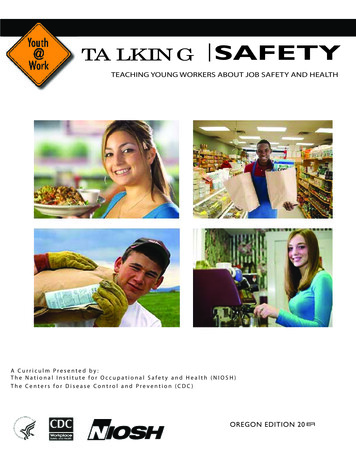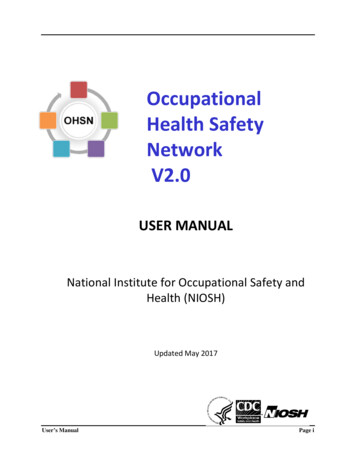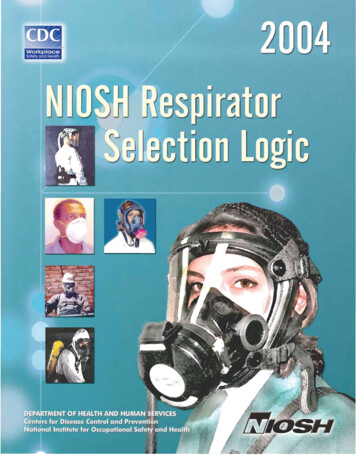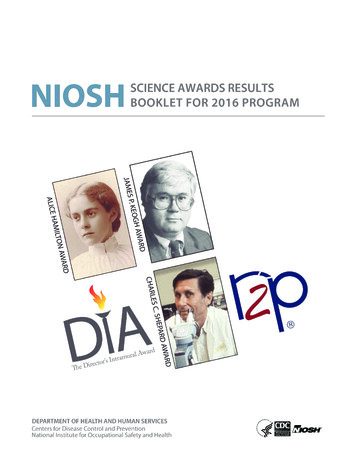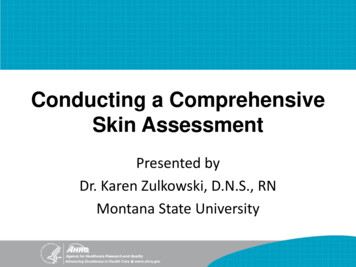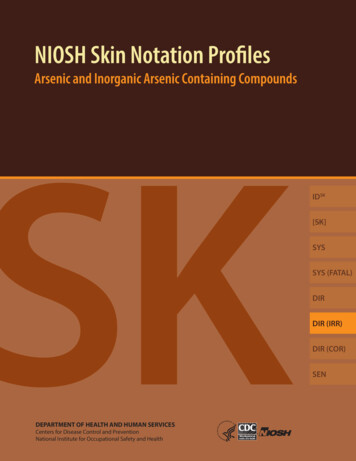
Transcription
NIOSH Skin Notation ProfilesArsenic and Inorganic Arsenic Containing CompoundsSKDEPARTMENT OF HEALTH AND HUMAN SERVICESCenters for Disease Control and PreventionNational Institute for Occupational Safety and HealthIDSK[SK]SYSSYS (FATAL)DIRDIR (IRR)DIR (COR)SEN
This page intentionally left blank.
NIOSH Skin Notation (SK) ProfileArsenic and Inorganic Arsenic Containing Compounds[CAS No. 7440-38-2]Naomi L. Hudson and G. Scott DotsonDEPARTMENT OF HEALTH AND HUMAN SERVICESCenters for Disease Control and PreventionNational Institute for Occupational Safety and Health
This document is in the public domain and may be freelycopied or reprinted.DisclaimerMention of any company or product does not constitute endorsement by the National Institute for Occupational Safety and Health (NIOSH). In addition, citations to websites external toNIOSH do not constitute NIOSH endorsement of the sponsoring organizations or their programs or products. Furthermore, NIOSH is not responsible for the content of these websites.Ordering InformationTo receive this document or information about other occupational safety and health topics,contact NIOSH:Telephone: 1-800-CDC-INFO (1-800-232-4636)TTY: 1-888-232-6348E-mail: cdcinfo@cdc.govor visit the NIOSH website: www.cdc.gov/nioshFor a monthly update on news at NIOSH, subscribe to NIOSH eNews by visitingwww.cdc.gov/niosh/eNews.Suggested CitationNIOSH [2017]. NIOSH skin notation profile: Arsenic and inorganic arsenic containing compounds. By Hudson NL, Dotson GS. Cincinnati, OH: U.S. Department of Health and HumanServices, Centers for Disease Control and Prevention, National Institute for Occupational Safetyand Health, DHHS (NIOSH) Publication No. 2017-184.DHHS (NIOSH) Publication No. 2017-184August 2017iiSkin Notation Profiles Arsenic and Inorganic Arsenic Containing Compounds
ForewordAs the largest organ of the body, the skin performs multiple critical functions, such as servingas the primary barrier to the external environment. For this reason, the skin is often exposedto potentially hazardous agents, including chemicals, which may contribute to the onset ofa spectrum of adverse health effects ranging from localized damage (e.g., irritant contactdermatitis and corrosion) to induction of immune-mediated responses (e.g., allergic contactdermatitis and pulmonary responses), or systemic toxicity (e.g., neurotoxicity and hepatotoxicity). Understanding the hazards related to skin contact with chemicals is a criticalcomponent of modern occupational safety and health programs.In 2009, the National Institute for Occupational Safety and Health (NIOSH) publishedCurrent Intelligence Bulletin (CIB) 61: A Strategy for Assigning New NIOSH Skin Notations[NIOSH 2009-147]. This document provides the scientific rationale and framework for theassignment of multiple hazard-specific skin notations (SKs) that clearly distinguish betweenthe systemic effects, direct (localized) effects, and immune-mediated responses caused byskin contact with chemicals. The key step within assignment of the hazard-specific SK is thedetermination of the hazard potential of the substance, or its potential for causing adversehealth effects as a result of skin exposure. This determination entails a health hazard identification process that involves use of the following: Scientific data on the physicochemical properties of a chemical Data on human exposures and health effects Empirical data from in vivo and in vitro laboratory testing Computational techniques, including predictive algorithms and mathematical models thatdescribe a selected process (e.g., skin permeation) by means of analytical or numericalmethods.This Skin Notation Profile provides the SK assignments and supportive data for arsenic andinorganic arsenic containing compounds. In particular, this document evaluates and summarizes the literature describing the hazard potential of the substance and its assessmentaccording to the scientific rationale and framework outlined in CIB 61. In meeting this objective, this Skin Notation Profile intends to inform the audience—mostly occupational healthpractitioners, researchers, policy- and decision-makers, employers, and workers in potentiallyhazardous workplaces—so that improved risk-management practices may be developed tobetter protect workers from the risks of skin contact with the chemicals of interest.John Howard, M.D.Director, National Institute forOccupational Safety and HealthCenters for Disease Control and PreventionSkin Notation Profiles Arsenic and Inorganic Arsenic Containing Compoundsiii
This page intentionally left blank.
ContentsForeword . . . . . . . . . . . . . . . . . . . . . . . . . . . . . . . . . . . . . . . . . . . . . . . . . . . . . . . . . . . . . . . . . . . . . .iiiAbbreviations . . . . . . . . . . . . . . . . . . . . . . . . . . . . . . . . . . . . . . . . . . . . . . . . . . . . . . . . . . . . . . . . . .viGlossary . . . . . . . . . . . . . . . . . . . . . . . . . . . . . . . . . . . . . . . . . . . . . . . . . . . . . . . . . . . . . . . . . . . . . . .viiAcknowledgments . . . . . . . . . . . . . . . . . . . . . . . . . . . . . . . . . . . . . . . . . . . . . . . . . . . . . . . . . . . . . . viii1 Introduction . . . . . . . . . . . . . . . . . . . . . . . . . . . . . . . . . . . . . . . . . . . . . . . . . . . . . . . . . . . . . . . . .11.1 General Substance Information: . . . . . . . . . . . . . . . . . . . . . . . . . . . . . . . . . . . . . . . . . . .11.2 Purpose . . . . . . . . . . . . . . . . . . . . . . . . . . . . . . . . . . . . . . . . . . . . . . . . . . . . . . . . . . . . . . . .11.3 Overview of SK Assignment . . . . . . . . . . . . . . . . . . . . . . . . . . . . . . . . . . . . . . . . . . . . . .12 Systemic Toxicity from Skin Exposure (SK: SYS) . . . . . . . . . . . . . . . . . . . . . . . . . . . . . . . . . .13 Direct Effects on Skin (SK: DIR) . . . . . . . . . . . . . . . . . . . . . . . . . . . . . . . . . . . . . . . . . . . . . . . .44 Immune-mediated Responses (SK: SEN) . . . . . . . . . . . . . . . . . . . . . . . . . . . . . . . . . . . . . . . . .45 Summary . . . . . . . . . . . . . . . . . . . . . . . . . . . . . . . . . . . . . . . . . . . . . . . . . . . . . . . . . . . . . . . . . . . .5References . . . . . . . . . . . . . . . . . . . . . . . . . . . . . . . . . . . . . . . . . . . . . . . . . . . . . . . . . . . . . . . . . . . . .5Appendix: Calculation of the SI Ratio for Arsenic . . . . . . . . . . . . . . . . . . . . . . . . . . . . . . . . . . .7Overview . . . . . . . . . . . . . . . . . . . . . . . . . . . . . . . . . . . . . . . . . . . . . . . . . . . . . . . . . . . . . . . . . .7Appendix References . . . . . . . . . . . . . . . . . . . . . . . . . . . . . . . . . . . . . . . . . . . . . . . . . . . . . . . .8Skin Notation Profiles Arsenic and Inorganic Arsenic Containing Compoundsv
AbbreviationsACGIHATSDRCIBcm2cm/hourDIRAmerican Conference of Governmental Industrial HygienistsAgency for Toxic Substances and Disease RegistryCurrent Intelligence Bulletinsquare centimeter(s)centimeter(s) per hourskin notation indicating the potential for direct effects to the skin followingcontact with a an CommissionGHSGlobally Harmonized System for Classification and Labelling of ChemicalsGPMTguinea pig maximization testIARCInternational Agency for Research on Cancer(IRR)subnotation of SK: DIR indicating the potential for a chemical to be a skinirritant following exposure to the skinkpskin permeation coefficientLD50dose resulting in 50% mortality in the exposed populationLDLodermal lethal doseLLNAlocal lymph node assayLOAELlowest-observed-adverse-effect levelMmolaritymgmilligram(s)mg/hourmilligram(s) per hourmg/kgmilligram(s) per kilogram body weightmLmilliliter(s)MWmolecular weightNIOSHNational Institute for Occupational Safety and HealthNOAELno-observed-adverse-effect levelNTPNational Toxicology ProgramOSHAOccupational Safety and Health AdministrationSENskin notation indicating the potential for immune-mediated reactions followingexposure of the skinSKskin notationSYSskin notation indicating the potential for systemic toxicity following exposure ofthe skinUSEPAUnited States Environmental Protection AgencyμLmicroliter(s)2μg/cmmicrogram(s) per square centimeter2μg/cm -hour microgram(s) per square centimeter per hourviSkin Notation Profiles Arsenic and Inorganic Arsenic Containing Compounds
GlossaryAbsorption—The transport of a chemical from the outer surface of the skin into both the skinand systemic circulation (including penetration, permeation, and resorption).Acute exposure—Contact with a chemical that occurs once or for only a short period of time.Cancer—Any one of a group of diseases that occurs when cells in the body become abnormaland grow or multiply out of control.Contaminant—A chemical that is (1) unintentionally present within a neat substance or mixture at a concentration less than 1.0% or (2) recognized as a potential carcinogen and presentwithin a neat substance or mixture at a concentration less than 0.1%.Cutaneous (or percutaneous)—Referring to the skin (or through the skin).Dermal—Referring to the skin.Dermal contact—Contact with (touching) the skin.Direct effects—Localized, non-immune-mediated adverse health effects on the skin, includingcorrosion, primary irritation, changes in skin pigmentation, and reduction/disruption of theskin barrier integrity, occurring at or near the point of contact with chemicals.Immune-mediated responses—Responses mediated by the immune system, includingallergic responses.Sensitization—A specific immune-mediated response that develops following exposure toa chemical, which, upon re-exposure, can lead to allergic contact dermatitis (ACD) or otherimmune-mediated diseases such as asthma, depending on the site and route of re-exposure.Substance—A chemical.Systemic effects—Systemic toxicity associated with skin absorption of chemicals after exposureof the skin.Skin Notation Profiles Arsenic and Inorganic Arsenic Containing Compoundsvii
AcknowledgmentsThis document was developed by the Education and Information Division (Paul Schulte, Ph.D.,Director). Naomi Hudson, Dr.P.H. MPH, was the project officer for this document, assisted ingreat part by G. Scott Dotson, Ph.D., MPH and Eric Esswein, M.Sc. The basis for this documentwas a report (Toxicology Excellence for Risk Assessment [TERA]) contracted by NIOSH and prepared by Bernard Gadagbui, Ph.D., and Andrew Maier, Ph.D.For their contribution to the technical content and review of this document, special acknowledgmentis given to the following NIOSH personnel:Division of Applied Research and TechnologyClayton B’Hymer, Ph.D.John Snawder, Ph.D.Mark Toraason, Ph.D.Division of Respiratory Disease StudiesGregory A. Day, Ph.D.Aleksander Stefaniak, Ph.D.Division of Surveillance, Hazard Evaluations, and Field StudiesMatt Dahm, M.Sc.Todd Niemeier, M.Sc.Aaron Sussell, Ph.D.Loren Tapp, M.D.Education and Information DivisionDevin Baker, M.Ed.Charles L. Geraci, Ph.D.Thomas J. Lentz, Ph.D.Richard W. Niemeier, Ph.D.Sudha Pandalai, M.D., Ph.D.Health Effects Laboratory DivisionStacey Anderson, Ph.D.H. Fredrick Frasch, Ph.D.Vic Johnson, Ph.D.Michael Luster, Ph.D.Paul Siegel, Ph.D.Berran Yucesoy, Ph.D.National Personal Protective Technology LaboratoryHeinz Ahlers, JD, M.Sc.Angie ShepherdviiiSkin Notation Profiles Arsenic and Inorganic Arsenic Containing Compounds
For their contribution to the technical content and review of this document, special acknowledgmentis given to the following CDC personnel:Office of Surveillance, Epidemiology and Laboratory Services/Epidemiologyand Analysis Program OfficeBarbara Landreth, M.A.In addition, special appreciation is expressed to the following individuals for serving as independent, external reviewers and providing comments that contributed to the development orimprovement of this document:Frank A. Barile, Ph.D., R.Ph. Full professor, Pharmaceutical Sciences, St. John’s UniversityCollege of Pharmacy and Allied Health Professionals, Queens, NYCarrie Redlich, MD, Ph.D., Senior Lexturer, Scottish Centre for Indoor Air, Division ofApplied Health Science, University of Aberdeen, Aberdeen, ScotlandGlenn Sipes, Ph.D., Professor Emeritus, Department of Pharmacology, University ofArizona, Tucson, AZG. Frank Gerberick, Ph.D., The Procter and Gamble Company, Cincinnati, OHDori Germolec, Ph.D., National Toxicology Program, National Institute for EnvironmentalHealth Sciences, Research Triangle, NCBen Hayes, M.D., Ph.D., Division of Dermatology, Vanderbilt School of Medicine, Nashville, TNJennifer Sahmel, M.Sc., CIH, ChemRisk, Boulder, COJames Taylor, M.D., Industrial Dermatology, The Cleveland Clinic, Cleveland, OHSkin Notation Profiles Arsenic and Inorganic Arsenic Containing Compoundsix
This page intentionally left blank.
Arsenic and Inorganic Arsenic Containing Compounds1 Introduction1.1 General Substance Information:Chemical: (Elemental) Arsenic and inorganicarsenic containing compounds*CAS No: 7440-38-2 (elemental arsenic)Molecular weight (MW): 74.9(elemental arsenic)Structural formula: As (elemental arsenic)Synonyms: Arsenic metal; arseniaUses: Arsenic is used as a wood preservativeand pesticide [ATSDR 2007].Molecular formula: As (elemental arsenic)1.2 Purpose1.3 Overview of SK AssignmentThis skin notation profile presents (1) abrief summary of epidemiological and toxicological data associated with skin contactwith arsenic and (2) the rationale behind thehazard-specific skin notation (SK) assignment for arsenic. The SK assignment is basedon the scientific rationale and logic outlinedin the Current Intelligence Bulletin (CIB) 61:A Strategy for Assigning New NIOSH SkinNotations [NIOSH 2009]. The summarizedinformation and health hazard assessmentare limited to an evaluation of the potentialhealth effects of dermal exposure to arsenic.A literature search was conducted throughJune 2017 to identify information on arsenic,including but not limited to data relating to itstoxicokinetics, acute toxicity, repeated-dosesystemic toxicity, carcinogenicity, biologicalsystem/function–specific effects (includingreproductive and developmental effects andimmunotoxicity), irritation, and sensitization.Information was considered from studies ofhumans, animals, or appropriate modelingsystems that are relevant to assessing theeffects of dermal exposure to arsenic. The criteria for the search strategy, evaluation, andselection of data are described in AppendixE in CIB 61: A Strategy for Assigning NewNIOSH Skin Notations [NIOSH 2009].Arsenic is potentially capable of causing skinirritation following skin contact. A criticalreview of available data has resulted in the following SK assignment for arsenic: SK: DIR(IRR). Table 1 provides an overview of thecritical effects and data used to develop the SKassignment for arsenic.2 Systemic Toxicity fromSkin Exposure (SK: SYS)Toxicokinetic studies following dermal exposure to arsenic and its inorganic compoundswere identified. Although no in vivo studiesin humans were identified, in vivo toxicokinetic studies in monkeys and rats demonstratethat arsenic is absorbed following dermalexposure. Wester et al. [1993] reported thatThis document summarizes the health risks associated with skin contact with inorganic arsenicand other substances that contain inorganicarsenic, including, but not limited to, arsenicmetal; arsenic acid (CAS No. 7778-39-4), arsenic trioxide (CAS No. 1327-53-3), arsenite (i.e.,potassium), and arsenates (i.e, calcium, lead,magnesium, sodium).*Skin Notation Profiles Arsenic and Inorganic Arsenic Containing Compounds1
Arsenic and Inorganic Arsenic Containing CompoundsTable 1. Summary of the SK assignment for arsenicSkin notationCritical effectAvailable dataSK: DIR (IRR)Skin irritationSufficient human data; limited animal data6.4% and 2.0% of the applied arsenic dose wereabsorbed through the skin when radioactivewater solutions of arsenic-73 as arsenic acid ata low (trace) level of 0.000024 micrograms persquare centimeter (μg/cm2), and a higher doseof 2.1 μg/cm2, respectively, were applied in avolume of 5 microliters (μL)/cm2 to the skin ofRhesus monkey for 24 hours. In rats, skin application of sodium arsenate aqueous solutionsfor one hour caused the initial accumulationof arsenic in the skin, with the absorption rateof 1.14–33.1 μg/cm2-hour for 0.01 to 0.2 molar(M) concentrations, followed by a slow and continuous distribution to the blood stream and toother tissues [Dutkiewicz 1977]. Thirty percentof the absorbed dose was eliminated in the urineand feces at 10 days after the skin application.Dutkiewicz [1977] calculated that this absorption rate would result in an overall absorptionrate of 0.8 to 23.2 milligrams (mg)/hour inhumans, assuming the surface area of the handsto be 700 cm2. Wester et al. [1993] reported apercutaneous absorption of 1.9% of the applieddose (when receptor fluid and skin concentrations were added) when the low level radioactivewater solution of arsenic-73 of 0.000024 μg/cm2, as used in the Rhesus monkey study, wasapplied to human skin in vitro for 24 hours. Thevalue from the in vitro study was less than thein vivo percutaneous absorption of 6.4% in theRhesus monkey. When arsenic-73 was appliedto 0.64 cm2 dermatosed pig skin samples for 16hours, Turkall [2003] reported total penetration(sum of the radioactivity of the initial dose in thereceptor fluid of 0.4% and the remaining doseof 44.2% bound to skin) as 44.6% of the initialdose recovered at the end of the 16-hour study.This study indicated that more arsenic boundto the skin following topical application thanpenetrated into receptor fluid. The potential ofarsenic to pose a skin absorption hazard wasnot evaluated with a predictive algorithm forestimating and evaluating the health hazards of2dermal exposure to substances [NIOSH 2009].The evaluation method compares an estimateddose accumulated in the body from skin absorption and an estimated dose from respiratoryabsorption associated with a reference occupational exposure limit (OEL). The ratio of theskin dose to the inhalation dose (SI ratio) couldnot be calculated because this method is notvalidated to determine skin absorption for inorganic compounds. More information about theSI ratio can be found in the appendix.Wester et al. [1993] demonstrated that the presence of other chemicals significantly enhancedthe dermal bioavailability of arsenic. The partition coefficient (kp) of arsenic chloride fromwater to powdered human stratum corneumwas reported as 1.1 104 [Wester et al. 1993]. It isimportant to note that lead arsenate compoundshave low solubility in water [Liu et al. 2009],and would not be as hazardous as some of theother inorganic compounds of arsenic describedin this document. Based on the available toxicokinetic studies in both humans and animals,arsenic has limited potential to be absorbedthrough human skin compared to animal skin.No estimated dermal lethal doses (LDLo) ofarsenic for humans have been identified. However, a dermal LD50 (the dose resulting in 50%mortality in the exposed animals) value ofgreater than 2,400 milligrams per kilogram bodyweight (mg/kg) was reported for female rats forarsenic as lead or calcium arsenate [Gaines 1960].Because the reported acute dermal LD50 valuefor the rat is greater than the critical dermal LD50value of 2000 mg/kg that identifies chemicalsubstances with the potential for acute dermaltoxicity [NIOSH 2009], arsenic and its inorganiccompounds are not considered acutely toxicityfollowing dermal exposure.No epidemiological or occupational exposurestudies or repeat-dose, sub-chronic or chronicSkin Notation Profiles Arsenic and Inorganic Arsenic Containing Compounds
OrganizationCarcinogenic designationNIOSH [2005]Potential occupational carcinogenNTP [2014]Known human carcinogenUSEPA [2014]Group A: Human carcinogenEuropean Parliament [2008]No GHS designationIARC [2012]Group 1: Carcinogenic to humansACGIH [2001]Group A1 : Confirmed human carcinogenACGIH American Conference of Governmental Industrial Hygienists; GHS Globally Harmonized System for Classification andLabelling of Chemicals; IARC International Agency for Research on Cancer; NIOSH National Institute for Occupational Safetyand Health; NTP National Toxicology Program; USEPA United States Environmental Protection Agency.*The listed cancer designations were based on data from nondermal (such as oral or inhalation) exposure since studies using thedermal route of exposure were unavailable.toxicity studies in animals were identified thatevaluated system effects following dermal exposure to arsenic or its inorganic compounds.No specialty studies were identified that evaluated biological system/function specific effects(including reproductive effects and immunotoxicity) following dermal exposure to arsenic.A case report by Robinson [1975] describedperipheral neuropathy in a man who was dermally treated with arsenic; however detailedinformation was not provided.No studies that evaluated the carcinogenicpotential of arsenic or its inorganic compoundsfollowing the dermal exposure route wereidentified. However, Liao et al. [2016] used skinequivalent (SE) models reconstituting humanfull-layered skin in vitro to evaluate epigeneticmodification and inflammatory promotioninduced by arsenic. Epidermal thickness wasstatistically significantly increased in the arsenictreated group (p 0/01), with 38.2% of the modelsexhibiting dysplasia. The SE models treated witha combination of arsenic and peripheral bloodmononuclear cells (PBMCs) also had a statistically significant increase compared to controls(p 0.0001), and 96% of the arsenic and PBMCSE models showed arsenic induced Bowen’sdisease-like features (the most prevalent form ofarsenic-induced skin cancer) [Liao et al. 2016].The classification of carcinogenicity of arsenicfollowing dermal exposure has not been done,but several organizations have developed suchclassifications based on data from other exposure routes. It should be noted that skin cancersin the form of Bowen’s disease, a squamous cellcarcinoma in situ, and basal cell carcinomas, arecommonly associated with the chronic ingestionand inhalation of arsenic [ATSDR 2007]. Therelationship between skin contact with arseniccontaining compounds and these diseases couldnot be determined because of the absence ofquality data on the subject. Table 2 summarizescarcinogenic designations of multiple governmental and nongovernmental organizations forarsenic.There is some indication from toxicokineticstudies that arsenic has measurable but limitedpotential to be absorbed through the skin ofhumans and animals [Dutkiewicz 1977; Westeret al. 1993; Turkall 2003]. The limited availabilityby the dermal route is consistent with the resultsof the acute dermal toxicity study identified inanimals [Gaines 1960] that indicates that arsenicis not acutely toxic despite its known acute toxicity via other routes. In addition, the lack of casereports, epidemiological studies, prolonged orrepeat-dose studies in animals precludes adequate evaluation of the potential of arsenic toSkin Notation Profiles Arsenic and Inorganic Arsenic Containing Compounds3Arsenic and Inorganic Arsenic Containing CompoundsTable 2. Summary of the carcinogenic designations* for arsenic bynumerous governmental and nongovernmental organizations
Arsenic and Inorganic Arsenic Containing Compoundscause systemic effects following dermal exposure. Therefore, on the basis of the data forthis assessment, arsenic is not assigned theSK: SYS notation.3 Direct Effects on Skin (SK: DIR)No human or animal in vivo studies on corrosivity ofarsenic or in vitro tests for corrosivity using human oranimal skin models or in vitro tests of skin integrityusing cadaver skin were identified. However, severaloccupational cases or human studies have reportedirritant contact dermatitis or cutaneous effects inpatients or workers exposed to arsenic [Pinto andMcGill 1953; Bourrain 1998; Mohamed 1998]. Skinreactions were mostly in the form of itching, dryness,hyperpigmentation, folliculitis, superficial ulceration,erythema, swelling, and papules, with vesicle formation in severe cases. In mice treated twice daily with50 μL of 0.4% potassium arsenite solution in 80%ethanol extensive ulceration was observed [Boutwell1963]. Mir [2017] investigated the proteome levelchanges in human skin keratinocyte cells exposed to100 millimolars of sodium arsenite over a period of 6months. An increase in reactive oxygen species (ROS)was noted, as well as overexpression of 42 proteins(including NAD(P)H dehydrogenase, glutamate9cysteine ligase catalytic subunit (GCLC), aldo-ketoreductase family 1 member C2 (AKR1C2) and(AKR1C3) and downregulation of proteins essential for terminal differentiation of keratinocytes(including periplakin, envoplakin, and involucrin)[Mir ea 2017].Boutwell [1963] evaluated the tumor initiation andpromotion potential of topical applications of potassium arsenite in ethanol. In an 18-week initiationstudy, mice received a total of 1.24 mg of potassiumarsenite divided into 8 applications over 5 days. Thetumor-promoting agent, croton oil (25 μL of 2.0%concentration in benzene) was then applied twiceweekly to the skin beginning 2 days after applicationof the test material. No increase in tumorigenicitywas observed [Boutwell 1963]. In a 30-week tumorpromotion study, 20 mice were given a singleapplication of 75 μg of 7,12-dimethylbenz(a)anthracene (DMBA) in 25 μL of acetone to a shaved areaon the skin, followed by twice daily (11 times a week)application with 50 μL of 0.4% potassium arsenitesolution in 80% ethanol. The exposure resultedin a weekly cumulative dose of 2.2 mg potassiumarsenite [Boutwell 1963]. Although hyperplasia andexternal ulceration were observed, no tumors were4identified. Boutwell [1963] concluded potassiumarsenite was neither a tumor initiator nor promoter.Case reports and human studies [Pinto and McGill1953; Bourrain 1998; Mohamed 1998]* demonstrate that chronic or high-dose dermal exposureto arsenic can result in irritant contact dermatitis.Some of the irritant symptoms observed couldpossibly reflect other ingredients. However, theeffects are consistent with irritation and are supported by the finding that prolonged exposure toarsenic following dermal application resulted inextensive ulceration at the site of application inmice [Boutwell 1963]. Therefore, on the basis ofthe data for this assessment, arsenic is assigned theSK: DIR (IRR) notation.4 Immune-mediatedResponses (SK: SEN)Several studies were identified that evaluatedthe potential of arsenic to cause skin sensitization in humans and animals. Wahlberg andBoman [1986] reported two out of 379 (0.5%)eczema patients patch tested with arsenic compounds [0.1% sodium arsenate in distilledwater (pH 8.5) and 0.05% sodium arsenite indistilled water (pH 10.0)] that showed positivetest results. The patients had no known previousexposure to arsenic compounds and the positiveresponse might have been due to a cross reactivity with nickel. In a guinea pig maximizationtest (GPMT), arsenic compounds (1.0% sodiumarsenate and 0.1% sodium arsenite) were notsensitizing to the skin, and were not rated asGrade I Allergens [Wahlberg and Boman 1986].An in vivo animal study using the GPMT didnot support the weak skin sensitization datain humans [Wahlberg and Boman 1986]. Thisassessment concludes that data are too limited to conclude that arsenic and its inorganiccompounds have the potential to cause skinsensitization in humans. Therefore, on thebasis of the data for this assessment, arsenic isnot assigned the SK: SEN notation.References in bold text indicate studies that serveas the basis of the SK assignments.*Skin Notation Profiles Arsenic and Inorganic Arsenic Containing Compounds
OrganizationSkin hazard designationNIOSH [2005]No designationOSHA [2017]No designationACGIH [2001]No designation*ACGIH American Conference of Governmental Industrial Hygienists; NIOSH National Institute for Occupational Safety andHealth; OSHA Occupational Safety and Health Administration.*Date accessed.5 SummaryReferencesThere is some indication from toxicokineticstudies that arsenic and its inorganic compounds have measurable, but limited potentialto be absorbed through the skin of humansand animals [Dutkiewicz 1977; Wester et al.1993; Turkall 2003]. The limited availability bythe dermal route is consistent with the resultsof the acute dermal toxicity study identifiedin animals [Gaines 1960] that indicates thatarsenic is not acutely toxic despite its knownacute toxicity via other routes. These data areinsufficient to adequately evaluate the potential of arsenic and its inorganic compounds tocause systemic effects, including skin cancers,following dermal exposure. Case reports andhuman studies [Pinto and McGill 1953; Bourrain 1998; Mohamed 1998] and data fromanimals [Boutwell 1963] indicate that chronicor high-dose dermal exposure to arsenic canresult in irritant contact dermatitis. An in vivoanimal study using the GPMT did not supportthe weak skin sensitization data in humans[Wahlberg and Boman 1986]. Therefore, on thebasis of these assessments, arsenic is assigned acomposite skin notation of SK: DIR (IRR).ACGIH (American Conference of GovernmentalIndustrial Hygienists) [2001]. Arsenic. In: Documentation of threshold limit values and biologicalexposure indices 7th ed., Vol. 1. Cincinnati, OH:American Conference of Governmental Industrial Hygienists.ATSDR [2007]. Toxicological profile for arsenic.Atlanta, GA: U.S. Department of Health andHuman Services, Public Health Service, Agencyfor Toxic Substance and Disease Registry(ATSDR), http://www.atsdr.cdc.gov/toxprofiles/tp.asp?id 22&tid 3. Accessed: 03-08-11.Bourrain JL, Morin C, Béani JC, et al. [1998]. Airborne contact dermatitis from cacodylic acid.Contact Dermatitis 3
pounds. By Hudson NL, Dotson GS. Cincinnati, OH: U.S. Department of Health and Human Services, Centers for Disease Control and Prevention, National Institute for Occupational Safety and Health, DHHS (NIOSH) Publication No. 2017-184. DHHS (NIOSH) Publication No. 2017-184 August 2017

